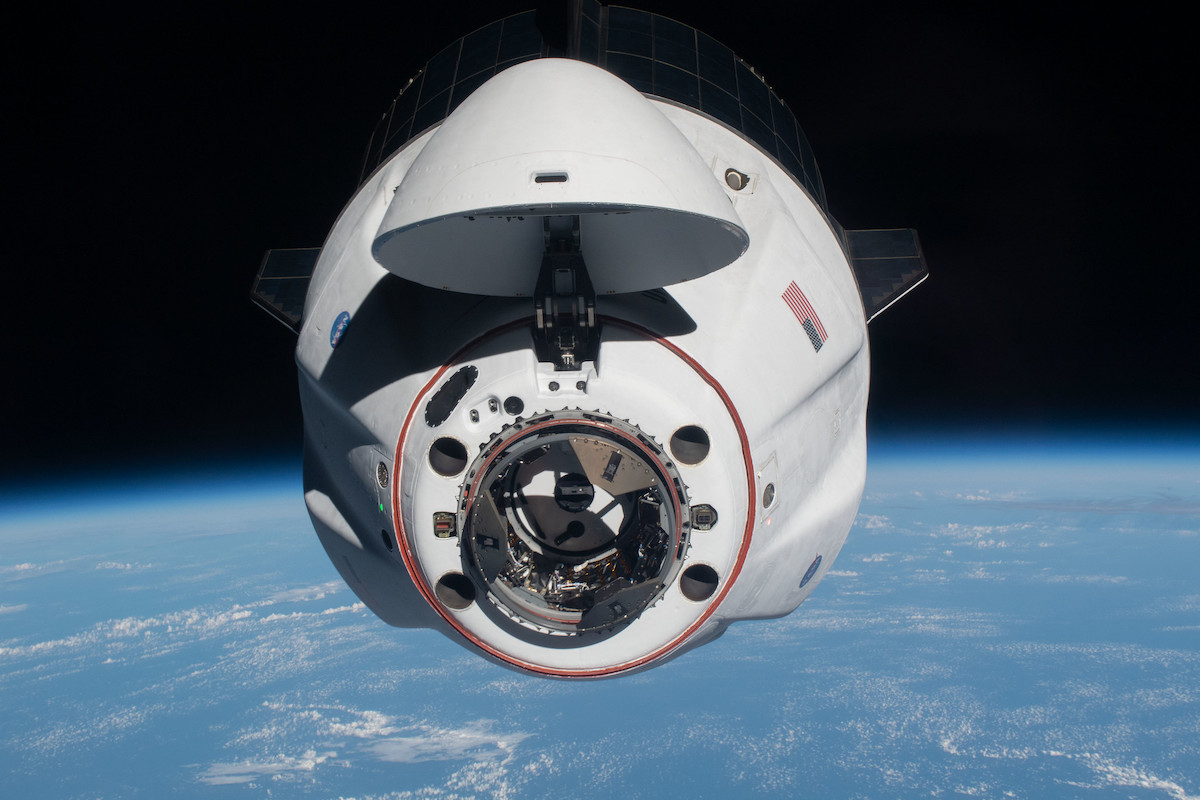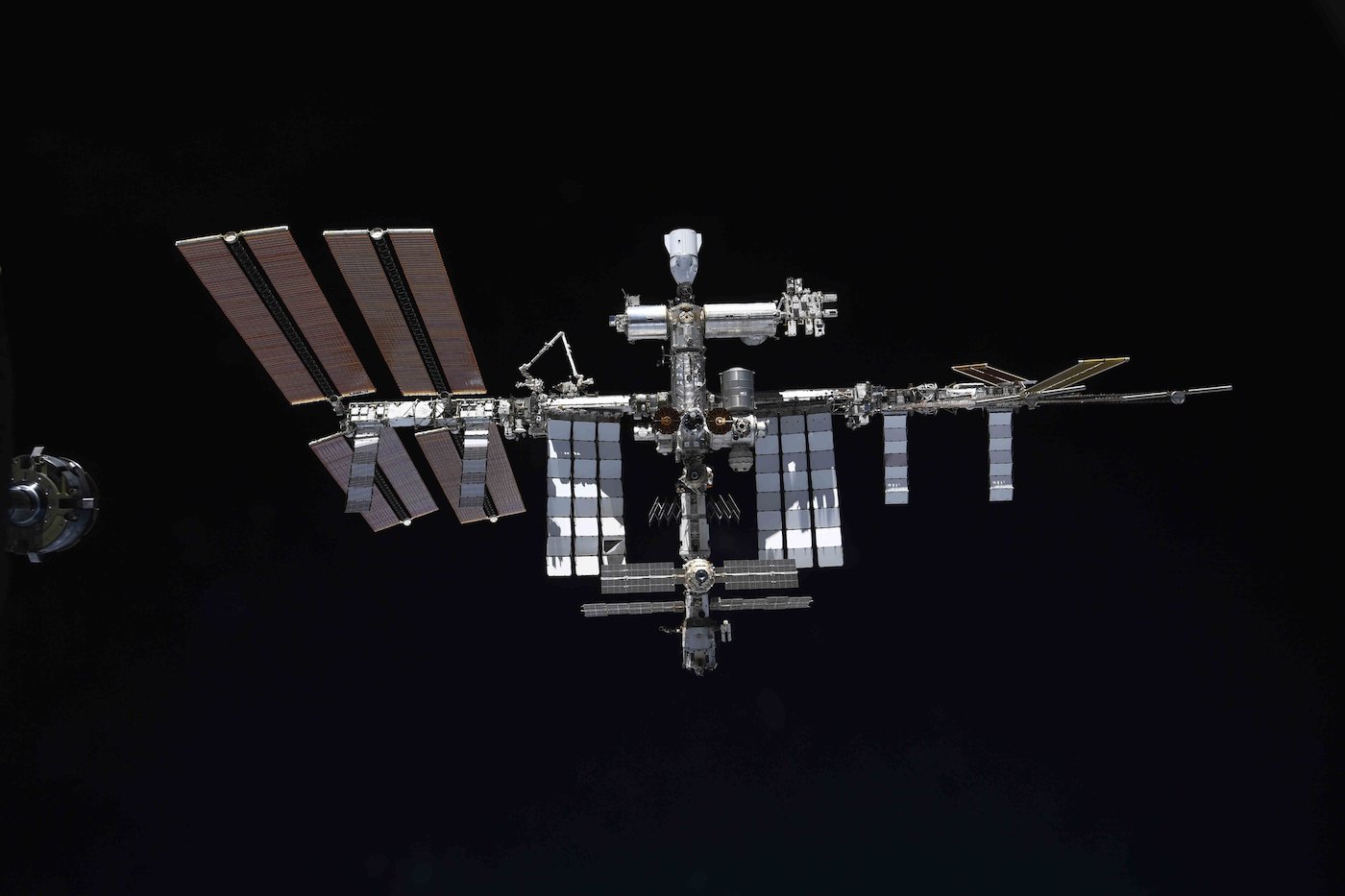
Four astronauts closing out an expedition of nearly 200 days in orbit floated into their SpaceX Crew Dragon capsule at the International Space Station Monday, a couple of hours before the ship was scheduled to undock and fly a 360-degree loop around the complex on the way back to Earth.
NASA commander Shane Kimbrough, pilot Megan McArthur, Japanese astronaut Akihiko Hoshide, and European Space Agency mission specialist Thomas Pesquet boarded their Crew Dragon spacecraft and closed a hatch leading to the space station at 12:12 p.m. EST (1712 GMT).
The astronauts planned to don their black and white SpaceX pressure suits and take their seats, perform leak checks, and prepare for undocking at 2:05 p.m. EST (1905 GMT) from a zenith, or upward-facing, port on the space station’s Harmony module.
Flying on autopilot, the Crew Dragon Endeavour spacecraft will back away to a distance of more than 660 feet (200 meters) above the space station. Then the capsule will fire its Draco thrusters to begin a flyaround of the space station, beginning above the outpost, then moving to positions behind, below, and in front of the complex.
The flyaround maneuver will allow the astronauts to photograph the exterior of the 450-ton space station complex as it soars more than 250 miles (400 kilometers) above the planet. It’s the first time a crew spacecraft has executed a 360-degree fly around of the station since the space shuttle’s retirement in 2011.
Russian Soyuz spacecraft have performed partial flyarounds of the space station.
The Dragon’s capability to conduct a flyaround is one of the final requirements NASA levied on SpaceX’s crew capsule that has not yet been tested in orbit.
“It will be the first time that Dragon has flown around … towards the Russian segment of the space station,” said Nicole Jordan, manager of the spacecraft office in NASA’s commercial crew program. “So although they have fully modeled all of the different features of station, and we have very high confidence that the Dragon navigation system will know where it is at all time, it is a first operation, so it’s probably a little bit of an increase in risk.
“If Dragon loses its navigation filter and becomes unconverged, it could abort, so we’re ready for that. All that’s been certified and looked at, and it’ll be really interesting to see that operation and be able to get the first images of station during a fly around since the shuttle days,” Jordan told Spaceflight Now in an interview.
While the astronauts get out of their seats to point cameras out of Dragon’s forward window, the capsule’s external cameras will record video of the space station throughout the maneuver, although the video will not be beamed down live unless the spacecraft is over SpaceX ground stations.
Around 90 minutes after starting the flyaround, the Crew Dragon spacecraft will pulse its Draco thrusters to depart the vicinity of the space station, setting the stage for a 16-minute deorbit burn with the capsule’s forward bulkhead rocket jets beginning at 9:41 p.m. EST (0241 GMT).

About five minutes before the start of the braking burn, Crew Dragon Endeavour will jettison its disposable trunk section, which will remain in orbit. Drag from Earth’s rarefied upper atmosphere will gradually reduce the trunk’s altitude until it re-enters uncontrolled and burns up, an event expected within a few weeks.
The reusable crew module containing Kimbrough, McArthur, Hoshide, and Pesquet will be committed to re-entry after the deorbit burn, targeting a splashdown in the Gulf of Mexico off the coast of Pensacola, Florida.
A SpaceX recovery vessel is on standby near the splashdown zone to hoist the capsule out of the water. Once the Dragon spacecraft is on the deck of the recovery ship, teams will open the hatch and help the four crew members out of the capsule.
Medical stretchers will be available for the astronauts, who have not experienced the effects of gravity since their launch April 23 from NASA’s Kennedy Space Center in Florida.
The splashdown will be the fourth time a SpaceX crew capsule has returned to Earth with crew members on-board, and it completes the second operational Crew Dragon flight — known as Crew-2 — to the space station under a multibillion-dollar contract with NASA.
NASA and SpaceX delayed the Crew Dragon’s undocking and return to Earth from last week in response to the postponed launch of a fresh team of astronauts on the Crew-3 mission. That launch was scheduled for Oct. 31 on top of a Falcon 9 rocket, but high winds in the Dragon’s offshore abort zones and a minor medical issue with one of the Crew-3 astronauts forced officials to delay the flight.

NASA mangers decided to swap the order of the crew rotation and bring the Crew-2 astronauts home before launching the Crew-3 mission. The change eliminated a planned handover in orbit between the Crew-2 and Crew-3 astronauts.
The Crew-3 launch is now scheduled for Wednesday at 9:03 p.m. EST (0203 GMT Thursday) from pad 39A at Kennedy Space Center. The Crew-3 mission’s Falcon 9 rocket and Crew Dragon Endurance space capsule have remained vertical on the launch pad during the delay.
During their eight-hour transit from the space station to the surface of the Gulf of Mexico, the astronauts aboard the Crew Dragon Endeavour spacecraft will be unable to use the capsule’s toilet system. SpaceX discovered a urine leak encountered on the all-civilian, three-day Inspiration4 flight on the Crew Dragon Resilience spacecraft, and inspections of the Endeavour capsule at the space station revealed it also had a leak in the astronaut waste system.
NASA says the astronauts will wear absorbent undergarments instead of having access to the toilet. The astronauts on the Crew-3 mission set for launch Wednesday will fly on a brand new SpaceX capsule with a modified toilet system to fix the problem that caused the urine leak.
The departure of the Crew-2 astronauts Monday leaves behind Russian commander Anton Shkaplerov, cosmonaut Pyotr Dubrov, and NASA astronaut Mark Vande Hei at the space station.
They will be joined by the next four Crew Dragon astronauts Thursday, assuming the Crew-3 mission blasts off as scheduled Wednesday night.
Email the author.
Follow Stephen Clark on Twitter: @StephenClark1.
